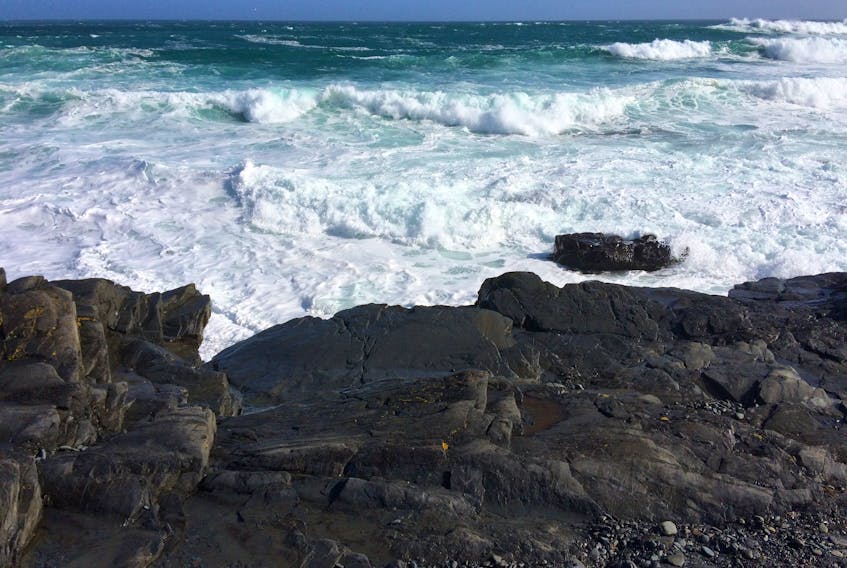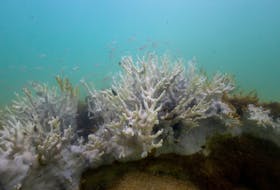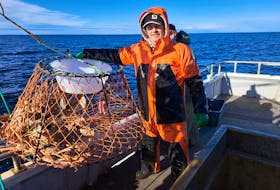At Adam’s Cove, the water is milk-white with the waves breaking.

Further out, the ocean is aquamarine and topped with skeins of foam. The big waves are cresting and crashing far out, their bellies torn out by the higher-reaching rocks. Black sea ducks ride out the deep slopes of the slab-sided swells, rising into view along the leading edge of the waves, then vanishing again as they slide down the backs.
It’s a Sunday as a nor’easter worked its way north and out to sea, and I can’t remember seeing this much height of water before in the wide, flat bay. It’s a bay where the bottom seems to reach up from beneath, slowing and exhausting the waves before they reach the beach gravels and the ragged rock reefs that parallel the shore at low water. Gulls are high above the water, crying, the winter sun bright and white and hurting your eyes. You can only look at the water for so long before you have to look away and rest your eyes, the white foam too white, the sun winking off of the planes and angles of the water’s surface.
Further down the shore, on the back of the headland that holds in Broad Cove, there is a narrow rocky cove shaped like a fist that gathers things: I’ve collected bergy bits and small growlers and driftwood there, stared at the collection of dead seabirds that occasionally cluster at the deepest curve of the beach against the cliff.
An old concrete wharf crumbles along the water’s edge there, and every 12th wave or so slaps square against the face of it, shooting great white columns of spume and water up and over the top of the single piece left standing of the wharf winch and gantry.
It doesn’t have to be the biggest wave to make the biggest wall of foam — it’s the perfect angle that matters most. There’s no apparent pattern to when the right wave will arrive.
The variation of the ocean is simply amazing: the pulse of the waves come in their own combinations, whipped up by a mix of physics and wave theory working itself out over miles upon miles of ocean. The sheer size and complexity of the ocean, the interplay it has on everything from our weather to the fishery, the web that depends on so many separate and distinct factors, means simple computation goes right out the window.
Nova Scotian coastal towns have had a rough winter this year, with a renewed focus on the historic size of storm surges, and questions about where those surges will reach in future years. Coastal roads have been overtopped, strewn with rocks and torn up. It’s put potential changes in clearer focus.
The variation of the ocean is simply amazing: the pulse of the waves come in their own combinations, whipped up by a mix of physics and wave theory working itself out over miles upon miles of ocean.
Maps of Halifax’s downtown have been redrawn with in-motion storm surge numbers to show how much of the historic downtown would be inundated, depending on the height of the surge.
It’s a discussion that’s going on in this province, too, though the biggest attention right now is on peak rainfall amount — also a function of the ocean’s effect on weather, though a slightly more discrete one.
At Broad Cove, I look at the waves, at the occasional glimpse of order in their disorder, and try to imagine the incredible complication of the equation that brings each shore-smacking wall of water. This same storm, further south, had waves that broke over the roofs of coastal houses in New England.
Two years ago, the entire topography of the beach at Broad Cove changed almost overnight: a rocky beach become sand, while up the coast, Western Bay saw a chunk of its sand siphoned away.
The ocean works its way through its particular calculations every day, and those calculations affect all of us.
If the inputs keep changing, there’s no doubt the outputs will, too. And if you can’t even calculate the period and size of the next 10 waves, if you can’t figure out something that comparatively simple, how can we help but be surprised about what might happen next?
Russell Wangersky is SaltWire Network’s Atlantic regional columnist. He can be reached at [email protected] Twitter: @Wangersky









